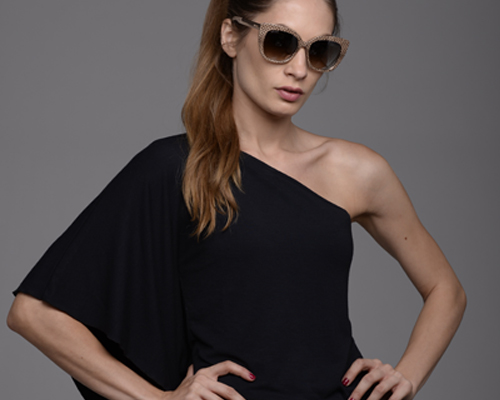Sunglasses
Long term exposure to UV radiation can affect the outer tissues of the eye such as the eyelids as well as internal structures of the eye such as the crystalline lens.
UV radiation which is present in natural sunlight (and also in artificial UV rays), can not only seriously damage your skin but your eyes too. Ultraviolet light has a higher frequency than violet light (ultra means beyond), violet light being the colour of the highest frequencies of visible light. However you don’t have to avoid the sun completely since being active is very important for your vitality and your wellbeing. Ultraviolet light is actually also responsible for the formation of bone strengthening vitamin D. Just keep in mind that you have to protect your eyes with a good pair of sunglasses, which fits perfectly on your facial features and is carefully selected just for you. Choose with our help from the latest brand collections available in both our stores.
Most of the ultra violet radiation from the sun is filtered out by the earth’s atmosphere and particularly the ozone layer but sun rays do reach the surface of the earth all year round, even on hazy days. With increased levels of UV radiation reaching the earth’s surface, largely due to stratospheric ozone layer depletion, it is important to take the necessary precautions to protect your eyes. UV rays become more intense in spring, even before temperatures get warmer. It is therefore very important to limit your exposure to direct sunlight. This is particularly important in spring and summer time, between the hours of 10.00am to 4.00pm when the UV light is stronger. Just remember that at a particular time during the day, if your shadow is shorter than you are, the sun’s rays are very strong and it is critical for you to protect not only your skin but your eyes as well.
Long term exposure to UV radiation can affect the outer tissues of the eye such as the eyelids as well as internal structures of the eye such as the crystalline lens. More specifically research has shown that long term exposure to the sun without adequate eye protection can increase the likelihood of developing the following eye disorders:
Cataract: a gradual clouding of the physiological crystalline lens which is directly connected with the blurring of vision
Macular Degeneration: the depletion (‘breakdown’) of the macula which is the most detail sensitive area of the retina, responsible for central vision
Skin cancer of the eyelids: Basal cell carcinoma is the most common type of cancer to affect the eyelids, and there is a strong linkage between this type of eyelid cancer and UV radiation
Photokeratitis (Snow blindness): This is a painful but temporary burn to the cornea (the transparent outermost tissue of the eye) caused for example by exposure to high levels of sun UV radiation during a day at the beach, or even reflection of UV radiation off the snow during a day of skiing
Pterygium: This is actually very frequently seen in hot and dusty countries like Cyprus. It is an abnormal but usually non-cancerous tissue growth on the inner or outer corner of the sclera, which is the white part of the eye. Pterygiums may need surgery to be removed because they may grow gradually, encroaching towards the cornea in which case they threaten its transparency and most importantly its clarity over the visual axis
Please do have in mind that Glaucoma which is a disease, during which the optic nerve gets damaged by increased pressure inside the eye, can make the eyes highly sensitive to light and glare, with some glaucoma medication suspected to even exacerbate the problem even further. Furthermore, Keratoconus which is a type of corneal ectasia, also may induce high sensitivity to light and glare.
CHILDREN need smaller versions of real, protective adult sunglasses and NOT TOY SUNGLASSES

Real facts about sunglasses:
- 100% UV blocking sunglasses (UV absorption up to 400nm) are important for protecting the delicate skin around the eyes, as well as the eyes themselves. Otherwise long hours in the sun without protecting your eyes, increase your chances of developing certain eye diseases
- The quality of the sunglasses is as important as the way the sunglasses fit on your face. Moreover you need to choose close fitting sunglasses with wide lenses that protect your eyes from every angle. Get all the correct advice on how sunglasses should fit on your face, providing the necessary coverage against the sun rays. Well-fitting sunglasses are more likely to protect your eyes from light coming in from different angles
- Darker lenses are not necessarily better. UV protection is what’s important and that comes from an invisible chemical in or applied to the lenses, not from the colour or darkness of the lenses
- CHILDREN need smaller versions of real, protective adult sunglasses and NOT TOY SUNGLASSES. We will help you choose sunglasses that fit your child’s face and shield the eyes in all angles. As far as harsh summer months, find for your child and why not you as well, a wide-brimmed hat to wear with your sunglasses. Wide-brimmed hats greatly reduce the amount of UV radiation that reaches the eyes
- Your sunglasses need to be kept in good condition, so care for them with cautious, following expert advice ,because if not, they might not continue to give your eyes the expected protection as when bought bran new
- Prescription sunglasses are made to precision and also treated with the appropriate UV blocking filters to do the job they are supposed to do and absolutely nothing less: help you see clearly based on your prescription and fully protect your eyes from the UV radiation
- Polarized sunlenses apart from providing UV protection, reduce reflected glare, such as sunlight that bounces off snow or water so they are particularly useful for skiing, fishing and driving


